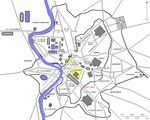San Gregorio Magno al Celio

San Gregorio Magno al Celio, also known as San Gregorio al Celio or simply San Gregorio, is a church in Rome, Italy, which is part of a monastery of monks of the Camaldolese branch of the Benedictine Order. On March 10, 2012, the 1,000th anniversary of the founding of the Camaldolese in 1012 was celebrated here at a Vespers service attended by Anglican and Catholic prelates and jointly led by Pope Benedict XVI and Rowan Williams, Archbishop of Canterbury. San Gregorio is located on the Caelian Hill, in front of the Palatine. Next to the basilica and monastery is a convent of nuns and a homeless shelter run by Mother Teresa of Calcutta's congregation, the Missionaries of Charity.
Excerpt from the Wikipedia article San Gregorio Magno al Celio (License: CC BY-SA 3.0, Authors, Images).San Gregorio Magno al Celio
Piazza di San Gregorio, Rome Municipio Roma I
Geographical coordinates (GPS) Address External links Nearby Places Show on map
Geographical coordinates (GPS)
| Latitude | Longitude |
|---|---|
| N 41.88547 ° | E 12.49064 ° |
Address
Chiesa dei Santi Andrea e Gregorio al Monte Celio
Piazza di San Gregorio
00184 Rome, Municipio Roma I
Lazio, Italy
Open on Google Maps








